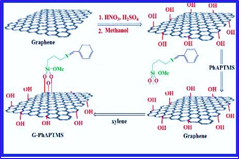Functionalized graphene-trimethoxyphenyl silane for toluene removal from workplace air by sorbent gas extraction method
Vol 2, Issue 02, Pages 45-54,*** Field: Analytical Methods in Occupational Health
Abstract
A new synthesized sorbent based on functionalizing graphene with N-Phenyl-3-aminopropyl trimethoxy silane (G-PhAPTMS, C12H21NO3Si), was developed as a novel sorbent for removal of toluene from air by sorbent gas extraction procedure (SGEP). By proposed method, the removal efficiency of G-PhAPTMS was compared with other sorbents such as activated carbon (AC), graphene (G) and graphene oxide (GO). The standard gas of toluene generated in pure air with different concentrations and the effects of parameters such as temperature (10-90 °C), flow rate (50-500 mL min-1) and the amount of sorbent (2-30 mg) were investigated. According to the results, increasing the flow rate and temperature had negative effects on the removal efficiency of all sorbents. The highest removal efficiency of G-PhAPTMS was obtained up to 35 °C and less than 250 mL min-1 (>95%). In optimized conditions, the amount of sorbent for toluene removal was achieved more than 10 mg of G-PhAPTMS.
References
S.K. Lim, H.S. Shin, K.S. Yoon, Kwack SJ, Um YM, Hyeon JH, et al. Risk assessment of volatile organic compounds benzene, toluene, ethylbenzene, and xylene (BTEX) in consumer products, J. Toxicol. Environ. Health, 77 (2014) 22-24.
F. Yavari, C. Van, M.A. Nistsche, Effect of acute exposure to toluene on cortical excitability, neuroplasticity, and motor learning in healthy humans, Arch. Toxicol., 92 (2018) 3149-3162.
P. Baltrėnas, E. Baltrėnaitė, V. Šerevičienė, P. Pereira, Atmospheric BTEX concentrations in the vicinity of the crude oil refinery of the Baltic region. Environmental monitoring and assessment, 182 (2011) 17-24.
J. Taylor, M. Fay, R.L. Williams, S.B. Wilbur, P.R. McClure, K. Zaccaria, Toxicological profile for toluene, Stacks Cdc. Gov., 8 (2017) 1-62.
F. Yavari, C. van Thriel, M.A. Nitsche, M.F. Kuo, Effect of acute exposure to toluene on cortical excitability, neuroplasticity, and motor learning in healthy humans, Arch. toxicol., 92 (2018) 3149-62.
D. Deschamps, C. Geraud, S. Dally, Cognitive functions in workers exposed to toluene: evaluation at least 48 hours after removal from exposure, Int. Arch. Occup. Environ. Health, 74 (2001) 285-288.
A. Romero-Anaya, M. Lillo-Ródenas, A. Linares-Solano, Spherical activated carbons for low concentration toluene adsorption, Carbon, 48 (2010) 53-59.
M. Lillo-Ródenas, J. Carratalá-Abril, D. Cazorla-Amorós, A. Linares-Solano, Usefulness of chemically activated anthracite for the abatement of VOC at low concentrations. Fuel. Process. Technol., 77 (2002) 331-6.
L. Van De Beld, M.G. Bijl, A. Reinders, B. Van Der Werf, K. Westerterp, The catalytic oxidation of organic contaminants in a packed bed reactor, Chem. eng. sci., 49 (1994) 61-73.
N. Bouazza, M. Lillo-Ródenas, A. Linares-Solano, Photocatalytic activity of TiO2-based materials for the oxidation of propene and benzene at low concentration in presence of humidity, Appl. Catal. B, 84 (2008) 691-8.
C. Hort, S. Gracy, V. Platel, L. Moynault, Evaluation of sewage sludge and yard waste compost as a biofilter media for the removal of ammonia and volatile organic sulfur compounds (VOSCs), Chem. Eng. J., 152 (2009) 44-53.
A.J. Fletcher, Y .Yüzak, K.M. Thomas, Adsorption and desorption kinetics for hydrophilic and hydrophobic vapors on activated carbon, Carbon, 44 (2006) 989-1004.
J.H. Yun, K.Y. Hwang, D.K. Choi, Adsorption of benzene and toluene vapors on activated carbon fiber at 298, 323, and 348 K, J. Chem. Eng. Data, 43 (1998) 843-5.
Q. Hu, J.J. Li, Z.P. Hao, L.D. Li, S.Z. Qiao, Dynamic adsorption of volatile organic compounds on organofunctionalized SBA-15 materials, Chem. eng. J, 149 (2009) 281-8.
M. Lillo-Ródenas, D. Cazorla-Amorós, A. Linares-Solano, Behaviour of activated carbons with different pore size distributions and surface oxygen groups for benzene and toluene adsorption at low concentrations, Carbon, 43 (2005) 1758-67.
A. Fuertes, G. Marban, D. Nevskaia Adsorption of volatile organic compounds by means of activated carbon fibre-based monoliths, Carbon, 41 (2003) 87-96.
A. Dhaouadi, L. Monser, N. Adhoum, Removal of rotenone insecticide by adsorption onto chemically modified activated carbons, J. hazad. mate, 181 (2010) 692-9.
M. Seredych, T.J. Bandosz, Adsorption of ammonia on graphite oxide/Al 13 composites. Colloids and Surfaces A, 353 (2010) 30-6.
A. Silvestre-Albero, J. Ramos-Fernández, Martínez-Escandell M, Sepúlveda-Escribano A, Silvestre-Albero J, Rodríguez-Reinoso F. High saturation capacity of activated carbons prepared from mesophase pitch in the removal of volatile organic compounds, Carbon , 48 (2010) 48-56.
L. Wang, D. Zhu, L. Duan, W. Chen, Adsorption of single-ringed N-and S-heterocyclic aromatics on carbon nanotubes, Carbon, 48 (2010) 3906-3915.
T. Wu, X. Cai, S. Tan, H. Li, J. Liu, W. Yang, Adsorption characteristics of acrylonitrile, p-toluenesulfonic acid, 1-naphthalenesulfonic acid and methyl blue on graphene in aqueous solutions, Chem. Eng. J., 173 (2011) 144-149.
X. Huang, X. Qi, F. Boey, H. Zhang, Graphene-based composites, Chem. Soc. Rev., 41(2012) 666-86.
J.C. Meyer, A.K. Geim, M. Katsnelson, K. Novoselov, T. Booth, Roth S. The structure of suspended graphene sheets, Nature, 446(2007)60-3.
H. Wang, X. Yuan, Y. Wu, H. Huang, X. Peng, G. Zeng, et al. Graphene-based materials: fabrication, characterization and application for the decontamination of wastewater and wastegas and hydrogen storage/generation, Adv. colloi. d interface. sci., 195 (2013)19-40.
X. Cai, S. Tan, M. Lin, A. Xie, W. Mai, X. Zhang, et al. Synergistic antibacterial brilliant blue/reduced graphene oxide/quaternary phosphonium salt composite with excellent water solubility and specific targeting capability, Langmu., 27(2011)28-35.
W. Wang, T. Sun, Y. Zhang, Y.B. Wang, Substituent effects in the π⋯ π interaction between graphene and benzene: An indication for the noncovalent functionalization of graphene, Comput. Theor. Chem., 1046 (2014) 64-69.
D. Gu, J.B. Fein, Adsorption of metals onto graphene oxide: Surface complexation modeling and linear free energy relationships, Colloid. Surf. A. Physicochem. Eng. Asp., 481 (2015) 319-27.
M.J. Allen, V.C. Tung, R.B. Kaner, Honeycomb carbon: a review of graphene. Chemical reviews, 110 (2009) 132-45.
S. Stankovich, D.A. Dikin, G.H. Dommett, K.M. Kohlhaas, E.J. Zimney, E.A. Stach, et al. Graphene-based composite materials. Natur, 442 (2006) 82-6.
K. Zhang, V. Dwivedi, C. Chi, J. Wu, Graphene oxide/ferric hydroxide composites for efficient arsenate removal from drinking water, J. hazard. mater, 182 (2010) 162-8.
S.T. Yang, S. Chen, Y. Chang, A. Cao, Y. Liu, H. Wang, Removal of methylene blue from aqueous solution by graphene oxide. Journal of colloid science, 359(2011)9-24.
Y. Gao, Y. Li, L. Zhang, H. Huang, J. Hu, S.M. Shah, et al, Adsorption and removal of tetracycline antibiotics from aqueous solution by graphene oxide. Journal of Colloid Sci., 368 (2012) 540-6.
G. Zhao, J. Li, X. Ren, C. Chen, X. Wang, Few-layered graphene oxide nanosheets as superior sorbents for heavy metal ion pollution management. Environ sci. technol, 45 (2011) 54-62.
G. Zhao, X. Ren, X. Gao, X. Tan, J. Li, C. Chen, et al, Removal of Pb (II) ions from aqueous solutions on few-layered graphene oxide nanosheets, Dalton Transactions, 40 (2011) 45-52.
W. Wang, J. Yu, Q. Xiang, B. Cheng, Enhanced photocatalytic activity of hierarchical macro/mesoporous TiO 2–graphene composites for photodegradation of acetone in air, Appl. Catal. B, 119 (2012) 9-16.
M.B.H. Abadi, H. Shirkhanloo, J. Rakhtshah, Air pollution control: The evaluation of TerphApm@ MWCNTs as a novel heterogeneous sorbent for benzene removal from air by solid phase gas extraction, Arab. J. Chem., 11 (2018) 287-301.
H. Sone, B. Fugetsu, T. Tsukada, M. Endo, Affinity-based elimination of aromatic VOCs by highly crystalline multi-walled carbon nanotubes, Talanta, 74(2008) 65-70.
Y.h. Shih, M.s. Li, Adsorption of selected volatile organic vapors on multiwall carbon nanotubes. J. Hazard. Mater, 154 (2008) 8-21.
M. Yao, Q. Zhang, D.W. Hand, D. Perram, R. Taylor, Adsorption and regeneration on activated carbon fiber cloth for volatile organic compounds at indoor concentration levels. J. Air. Waste. Manag. Assoc., 59 (2009) 31-6.
S. Ghorai, K. Pant, Equilibrium, kinetics and breakthrough studies for adsorption of fluoride on activated alumina, Sep. Purif. Technol., 42 (2005) 65-71.
N. Mohan, G. Kannan, S. Upendra, R. Subha, N. Kumar, Breakthrough of toluene vapours in granular activated carbon filled packed bed reactor. J. hazard. mater, 168 (2009) 77-81.
M.R. Samarghandi, A. Poormohammadi, S. Shanesaz, K. Godini, Comparison Between the Performance of Activated Carbon and Graphene in Removal of Reactive Red 198, Avicenna, J. Environ. Health. Eng., 4 (2017) 17-23.

Copyright (c) 2019 Analytical Methods in Environmental Chemistry Journal

This work is licensed under a Creative Commons Attribution 4.0 International License.
JOURNAL PUBLISHING AGREEMENT
PLEASE PROVIDE US THE FOLLOWING INFORMATION,
Article entitled:
Corresponding author:
To be published in the journal:
Your Status
I am the sole author of the manuscript
- I am an Iranian government employee.
- I am a European government employee
- I am a Asian government
- None of the above
I am one author signing on behalf of all co-authors of the manuscript
- I am an Iranian government employee.
- I am a European government employee
- I am a Asian government
- None of the above
Please tick the above blanks (as appropriate), review the Journal Publishing Agreement, and then sign and date the document in black ink.
Published Journal Article: the author may share a link to the formal publication through the relevant DOI. Additionally theses and dissertations which contain embedded Published Journal Articles as part of the formal submission may be hosted publicly by the awarding institution with a link to the formal publication through the relevant DOI. Any other sharing of Published Journal Articles is by agreement with the publisher only.
Signed: ______________________________________ Name printed: ___________________________________________
Title and Company (if employer representative): _______________________Date: __________________________________














